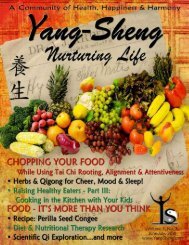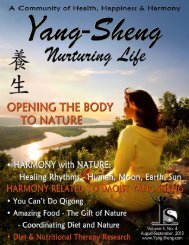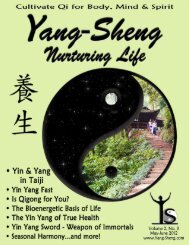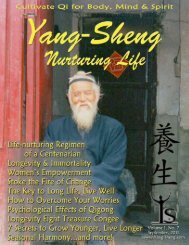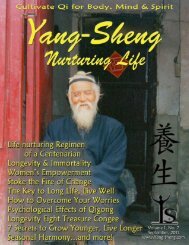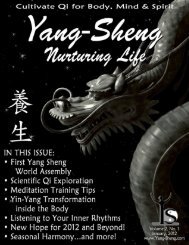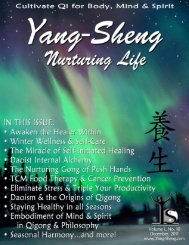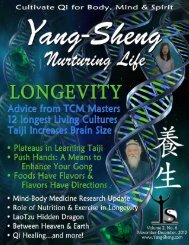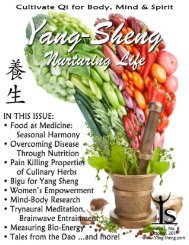Download - Yang-Sheng
Download - Yang-Sheng
Download - Yang-Sheng
Create successful ePaper yourself
Turn your PDF publications into a flip-book with our unique Google optimized e-Paper software.
Keep the body symmetrical with the shoulders<br />
level and arms even. Being in alignment means that<br />
the internal organs are in the proper place and the<br />
skeleton and ligaments can do their job of supporting<br />
the body. This allows your body to function normally.<br />
Visualize a string connecting the crown of the<br />
head with the heavens and extending down through<br />
the body toward the center of the earth. Mentally<br />
pull on the string in both directions. Let all the muscles<br />
relax to release any unnecessary tension. Stand<br />
long enough to become familiar with the posture to<br />
help you know what it should be like when practicing<br />
your taiji.<br />
A Simple Exercise for Song<br />
Song means to open up your joints so the qi can<br />
flow. What does that really mean? It means to stretch<br />
the ligaments that hold the joints together. Tension<br />
fades away when the joints are stretched and opened.<br />
The flow of qi improves and movement becomes<br />
easier and smoother. How do we do that? Here is a<br />
simple exercise to help learn about song.<br />
Look at the inside of the wrists. At the base of<br />
the palm, right where it joins with the wrist, there is<br />
a line, or fold, in the skin. You can usually see this<br />
line on both hands. Bring the wrists together, palms<br />
facing each other, and align the two lines. Bring the<br />
hands together in a prayer position. Look at the finger<br />
tips. For many people, the fingertips will not be<br />
even. One hand is larger than the other. Note which<br />
hand is smaller. If they seem to be the same size,<br />
note which hand is the non-dominant hand.<br />
Now, focus on the smaller or non-dominant<br />
hand. Start with the little finger. Look at the first<br />
knuckle, the one closest to the palm. Visualize that<br />
the joint is expanding and stretching. Keep your attention<br />
there for about 5 seconds. Move to the next<br />
joint on the little finger. Visualize that joint is expanding<br />
and stretching. Focus for about 5 seconds<br />
again. Move your attention to the last joint in the finger<br />
and repeat.<br />
Move your attention to the next finger, the ring<br />
finger. Look at the first knuckle and do the same<br />
visualization. Follow this with the rest of the knuckles.<br />
Move to the middle finger, then the pointing finger,<br />
and then the thumb. Do the same visualization<br />
for each knuckle. Now, visualize the entire hand.<br />
Imagine that the whole hand is expanding, that it is<br />
growing with each heartbeat.<br />
Now, line up the hands again from the line at the<br />
wrist. Most people find that their hand has grown a<br />
little bit. The size of the bones certainly didn't increase<br />
in that short time. The increase has to come<br />
from the space between the bones, the joints. This is<br />
one aspect of song.<br />
Forms Practice<br />
Taiji is practiced at a slow pace for many reasons.<br />
One reason is to make it easier to identify any<br />
areas of tightness in the muscles and joints. Slow<br />
movement allows us to feel every muscle as it contracts<br />
and loosens. Quick movements hide the tension.<br />
Use this same visualization technique for the rest<br />
of the body. Don't worry about the measuring or<br />
comparing here. You know it works. Start with the<br />
shoulders. Open up the shoulder joints during taiji<br />
warm-ups. Focus on the shoulders during forms<br />
practice. It may be necessary to pause once in a<br />
while to bring your attention back to the shoulders.<br />
Spend several practice sessions on this until it feels<br />
natural.<br />
The next time you practice, continue this visualization<br />
for the spine, hips, knees, etc. Then extend<br />
this technique for the entire body. The ability to continuously<br />
maintain song throughout the body will<br />
develop with practice.<br />
Eric Borreson, a student and<br />
teacher, finds teaching tai chi,<br />
qigong, and meditation to be a path<br />
to a more meaningful life. Eric is the<br />
founder and director of Meditation<br />
in Motion, specializing in teaching<br />
about living healthier and happier<br />
lives. He teaches tai chi, qigong, and<br />
meditation at the prestigious Heartland<br />
Spa, a top 10 destination spa, located in Gilman, IL. In<br />
addition, he teaches tai chi (<strong>Yang</strong> 24, Sun-style tai chi, and Dr.<br />
Lam’s Tai Chi for Arthritis and Tai Chi for Diabetes) at other<br />
venues. He conducts workshops and teaches private lessons on<br />
request. He writes a weekly wellness column at<br />
http://eric-taichi.blogspot.com.<br />
September—October 2012 <strong>Yang</strong>-<strong>Sheng</strong> (Nurturing Life) 17



